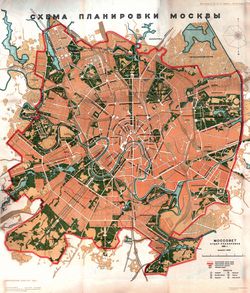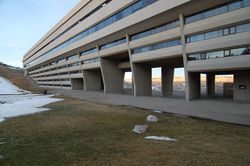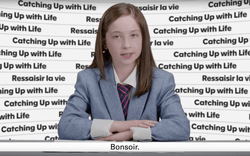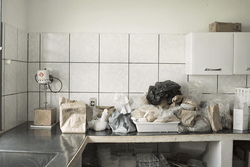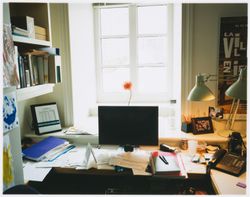Pedro Ignacio Alonso est chercheur en résidence au CCA, professeur à la Universidad Católica au Chili et professeur invité à la Architectural Association à Londres. Il présente les premières installations d’usines soviétiques composées de grands panneaux de béton dans le Cuba de Fidel Castro et le Chili de Salvador Allende pendant la guerre froide. Cliquez ici pour(...)
Maison Shaughnessy
26 mai 2011 , 18h
Séminaire de chercheur en résidence : Pedro Ignacio Alonso
Actions:
Description:
Pedro Ignacio Alonso est chercheur en résidence au CCA, professeur à la Universidad Católica au Chili et professeur invité à la Architectural Association à Londres. Il présente les premières installations d’usines soviétiques composées de grands panneaux de béton dans le Cuba de Fidel Castro et le Chili de Salvador Allende pendant la guerre froide. Cliquez ici pour(...)
Maison Shaughnessy
Sous-série
AP116.S3.SS20
Description:
Sub-series documents the planning and production of Public Fear: What's So Scary About Architecture?, issue 18 of ANY magazine (May) and its accompanying In ANY Event Symposium, held January 25, 1997 at the Guggenheim Museum, New York City, New York. Sub-series is arranged into seven files, by object type. Material in sub-series was produced between 1996 and 1997. Sub-series contains drafts, research materials, documents relating to publicity, articles, illustrations and photographs, mock-ups, videocassettes and audiocassettes of symposium and copies of the issue.
1996-1997
Public Fear: What's So Scary About Architecture?
Actions:
AP116.S3.SS20
Description:
Sub-series documents the planning and production of Public Fear: What's So Scary About Architecture?, issue 18 of ANY magazine (May) and its accompanying In ANY Event Symposium, held January 25, 1997 at the Guggenheim Museum, New York City, New York. Sub-series is arranged into seven files, by object type. Material in sub-series was produced between 1996 and 1997. Sub-series contains drafts, research materials, documents relating to publicity, articles, illustrations and photographs, mock-ups, videocassettes and audiocassettes of symposium and copies of the issue.
Sub-series 20
1996-1997
Projet
AP148.S1.1970.PR02
Description:
The project series documents Poli's work on the Interplanetary Architecture project, which was also made into a film by Superstudio directed by Alessandro Poli (the film is not included in the fonds). The project reflects Poli's deep fascination with the moon landing in 1969. Poli uses this major media event as a catalyst for thinking about a new approach to architecture and tools for design, including the idea that film and the movie camera should become part of the toolset. The project also seems to be in some way a response to Epoch magazine's challenge for a "Primo concorso di architettura nello spazio" (the first architectural competition in space), and includes much imagery and textual references to a new road or architectural links between the earth and other planets, including an earth moon highway. In his storyboard, Poli also makes reference to his earlier Piper project, and some imagery features wheels and an amusement park. The Interplanetary Architecture project was exhibited by Superstudio in Rome in 1972 and featured in "Casabella" magazine in April 1972 (no. 364). The project was also featured in the 2010 CCA exhibition "Other Space Odysseys". In the accompanying CCA publication, Poli describes this project as "a voyage off earthbound routes in quest of architecture unfettered by the urban nightmare, by induced needs or by planning as the only tool for regulating and solving the world's problems" (Poli quoted in Borasi and Zardini, 2010, 110). Poli's work on this project is deeply tied to the Zeno project, which was also featured in this exhibition and is included in this fonds (see AP148.S1.1972.PR01). For the Zeno project, Poli envisioned a dialogue between astronaut Buzz Aldrin and an Italian peasant, Zeno of Riparbella. Poli felt that these two shared a similarity in that both their homes were isolated capsules, one that provided a lens from which to see the rest of the world and understand their place in it. The material in the series includes numerous photomontages and collages of astronauts in space, as well as drawings of plantery shapes and structures. There are also texts, some of which include calculations of distances and diameters of planets, as well as notebooks and sketchbooks, many of which Poli included in a folder he entitled "Storyboard." The series also includes an unsent letter from Poli to Adolfo Natalini which describes how, after the moon landing, everything - the planet, the moon, the stars - is architecture, and that this will necessitate the need for new design tools, such as the movie camera. Some works are signed Alessandro Poli-Superstudio. Source cited: Giovanna Borasi and Mirko Zardini, eds., Other Space Odysseys, Montreal and Baden: Canadian Centre for Architecture/Lars Müller Publishers, 2010.
1969-1971
Architettura Interplanetaria [Interplanetary Architecture] (1970-1971)
Actions:
AP148.S1.1970.PR02
Description:
The project series documents Poli's work on the Interplanetary Architecture project, which was also made into a film by Superstudio directed by Alessandro Poli (the film is not included in the fonds). The project reflects Poli's deep fascination with the moon landing in 1969. Poli uses this major media event as a catalyst for thinking about a new approach to architecture and tools for design, including the idea that film and the movie camera should become part of the toolset. The project also seems to be in some way a response to Epoch magazine's challenge for a "Primo concorso di architettura nello spazio" (the first architectural competition in space), and includes much imagery and textual references to a new road or architectural links between the earth and other planets, including an earth moon highway. In his storyboard, Poli also makes reference to his earlier Piper project, and some imagery features wheels and an amusement park. The Interplanetary Architecture project was exhibited by Superstudio in Rome in 1972 and featured in "Casabella" magazine in April 1972 (no. 364). The project was also featured in the 2010 CCA exhibition "Other Space Odysseys". In the accompanying CCA publication, Poli describes this project as "a voyage off earthbound routes in quest of architecture unfettered by the urban nightmare, by induced needs or by planning as the only tool for regulating and solving the world's problems" (Poli quoted in Borasi and Zardini, 2010, 110). Poli's work on this project is deeply tied to the Zeno project, which was also featured in this exhibition and is included in this fonds (see AP148.S1.1972.PR01). For the Zeno project, Poli envisioned a dialogue between astronaut Buzz Aldrin and an Italian peasant, Zeno of Riparbella. Poli felt that these two shared a similarity in that both their homes were isolated capsules, one that provided a lens from which to see the rest of the world and understand their place in it. The material in the series includes numerous photomontages and collages of astronauts in space, as well as drawings of plantery shapes and structures. There are also texts, some of which include calculations of distances and diameters of planets, as well as notebooks and sketchbooks, many of which Poli included in a folder he entitled "Storyboard." The series also includes an unsent letter from Poli to Adolfo Natalini which describes how, after the moon landing, everything - the planet, the moon, the stars - is architecture, and that this will necessitate the need for new design tools, such as the movie camera. Some works are signed Alessandro Poli-Superstudio. Source cited: Giovanna Borasi and Mirko Zardini, eds., Other Space Odysseys, Montreal and Baden: Canadian Centre for Architecture/Lars Müller Publishers, 2010.
Project
1969-1971
Rejoignez-nous ce soir, 9 juin 2011 à 18 h dans la maison Shaughnessy. La chercheure en résidence Elisabeth Essaïan présente ses recherches sur l’urbanisme de la période stalinienne et considère de façon critique la réception, dans les publications en Europe et en Amérique du Nord, de la production des années 1920-50. Cliquez ici pour lévénement Facebook. Consultez(...)
Maison Shaughnessy
9 juin 2011 , 18h
Séminaire de chercheur en résidence : Elisabeth Essaïan
Actions:
Description:
Rejoignez-nous ce soir, 9 juin 2011 à 18 h dans la maison Shaughnessy. La chercheure en résidence Elisabeth Essaïan présente ses recherches sur l’urbanisme de la période stalinienne et considère de façon critique la réception, dans les publications en Europe et en Amérique du Nord, de la production des années 1920-50. Cliquez ici pour lévénement Facebook. Consultez(...)
Maison Shaughnessy
Michelangelo Sabatino, chercheur en résidence 2011, offre un tour d’horizon de ses recherches en cours sur la contribution d’Arthur Erickson au façonnement de la ville du XXe siècle. Cliquez ici pour lévénement Facebook.
Maison Shaughnessy
Presenté en anglais Mot(s)-clé(s):
Michelangelo Sabatino, séminaire de chercheur en résidence
11 août 2011, 18h
Séminaire de chercheur en résidence : Michelangelo Sabatino
Actions:
Description:
Michelangelo Sabatino, chercheur en résidence 2011, offre un tour d’horizon de ses recherches en cours sur la contribution d’Arthur Erickson au façonnement de la ville du XXe siècle. Cliquez ici pour lévénement Facebook.
Maison Shaughnessy
Presenté en anglais Mot(s)-clé(s):
Michelangelo Sabatino, séminaire de chercheur en résidence
Projet
AP164.S1.2005.D3
Description:
The project series documents the design for an artificial hill and serves as the finish-line for the “Elfstedentocht”, Leeuwarden, Netherlands, at the International Architecture Biennale Rotterdam 2005. The firm identified this project as number 201. "The finish of the great race of the Elfstedentocht should be accompanied by a three-dimensial event which signals the site in the memory of the citizen. If from there, furthermore, the last part of the race is dominated we will be able to imagine that this three-dimensional event is a hybrid between a tribune and a landscaping milestone. […] If towards the South and East it disposes of a slope consisting of artificial lawn with solarium and tribunes above the canal and a scating [sic] park, then towards the North it could house the sport installations with tribunes and a climbing zone with the result that this minimum architectural organization could give life to the site during all year basing on the small sports center, solarium and skating track. A shelter structure crowns the artificial hill composing a lookout spot from where one dominates the whole city and the surrounding landscape." (ARCH270975) Documenting the project are conceptual and presentation drawings, digital, graphic and reference materials, correspondence, publications, competition documents, and agreements.
1982, 2005, predominant 2005
Colina artificial, International Architecture Biennale Rotterdam, Leeuwarden, Netherlands (2005)
Actions:
AP164.S1.2005.D3
Description:
The project series documents the design for an artificial hill and serves as the finish-line for the “Elfstedentocht”, Leeuwarden, Netherlands, at the International Architecture Biennale Rotterdam 2005. The firm identified this project as number 201. "The finish of the great race of the Elfstedentocht should be accompanied by a three-dimensial event which signals the site in the memory of the citizen. If from there, furthermore, the last part of the race is dominated we will be able to imagine that this three-dimensional event is a hybrid between a tribune and a landscaping milestone. […] If towards the South and East it disposes of a slope consisting of artificial lawn with solarium and tribunes above the canal and a scating [sic] park, then towards the North it could house the sport installations with tribunes and a climbing zone with the result that this minimum architectural organization could give life to the site during all year basing on the small sports center, solarium and skating track. A shelter structure crowns the artificial hill composing a lookout spot from where one dominates the whole city and the surrounding landscape." (ARCH270975) Documenting the project are conceptual and presentation drawings, digital, graphic and reference materials, correspondence, publications, competition documents, and agreements.
Project
1982, 2005, predominant 2005
articles
Réinitialiser le social
Soirée, famille, Quoi si ce n’est pas la famille?, Miranda July, Other Architects, Grace Mortlock, David Neustein, Elena Schütz, Julian Schubert, Leonard Streich, Something Fantastic, Edit Collective, Marisa Morán Jahn, Rafi Segal, Carehaus, Johanna Hurme, 5468796 Architecture, Nahira Gerster-Sim, Frida Escobedo, Kumiko Inui, Emanuel Admasu, AD-WO
7 juin 2021
Quoi, si ce n’est pas la famille?
Des invités d'horizons multidisciplinaires discutent des implications spatiales liées à la transformation continue des idées sur la famille
Actions:
Réinitialiser le social
Alors que le climat de la Terre atteint un état d’instabilité constante, la prise de conscience de l’impact du réchauffement planétaire sur les droits de l’homme et l’augmentation des conflits sociaux, ne fait que s’accentuer. Une moindre attention a été accordée aux façons dont la violence politique et l’abus de droits humains, dans le passé comme dans le présent,(...)
Théâtre Paul-Demarais
1 décembre 2016, 18h
Dans les frontières du changement climatique (Vers une politique des droits non humains)
Actions:
Description:
Alors que le climat de la Terre atteint un état d’instabilité constante, la prise de conscience de l’impact du réchauffement planétaire sur les droits de l’homme et l’augmentation des conflits sociaux, ne fait que s’accentuer. Une moindre attention a été accordée aux façons dont la violence politique et l’abus de droits humains, dans le passé comme dans le présent,(...)
Théâtre Paul-Demarais
Le bâtiment du Centre Canadien d’Architecture (CCA) fut conçu à la fois comme une extension de la maison Shaughnessy, une résidence construite au XIXe siècle, et comme un objet à part entière de la collection. Le CCA est inauguré en 1989 avec l’exposition Architecture et paysage qui présentait le nouvel édifice et ses jardins. En tant qu’acteur essentiel dans la recherche(...)
Vitrines
22 avril 2015 au 30 novembre 2015
Photographies du CCA, 1987-2015
Actions:
Description:
Le bâtiment du Centre Canadien d’Architecture (CCA) fut conçu à la fois comme une extension de la maison Shaughnessy, une résidence construite au XIXe siècle, et comme un objet à part entière de la collection. Le CCA est inauguré en 1989 avec l’exposition Architecture et paysage qui présentait le nouvel édifice et ses jardins. En tant qu’acteur essentiel dans la recherche(...)
Vitrines
archives
Niveau de description archivistique:
Collection
CD034
Résumé:
The SAAL Process exhibition collection consists of reproductions of several objects used in the exhibition “The SAAL Process, Housing in Portugal 1974–76.” It was created by the Museu Serralves and travelled to the Canadian Center for Architecture (CCA) in 2015. The collection contains reproductions of drawings, presentation panels and photographs dating from 1974 to 1979. Born out of the Portuguese Revolution of 25 April 1974, the Serviço Ambulatório de Apoio Local (Local Ambulatory Support Service) was a pioneering architectural and political experiment designed to address extreme housing shortages and poor living conditions in Portuguese cities.
1974-1979
Collection de l’exposition Le processus du SAAL
Actions:
CD034
Résumé:
The SAAL Process exhibition collection consists of reproductions of several objects used in the exhibition “The SAAL Process, Housing in Portugal 1974–76.” It was created by the Museu Serralves and travelled to the Canadian Center for Architecture (CCA) in 2015. The collection contains reproductions of drawings, presentation panels and photographs dating from 1974 to 1979. Born out of the Portuguese Revolution of 25 April 1974, the Serviço Ambulatório de Apoio Local (Local Ambulatory Support Service) was a pioneering architectural and political experiment designed to address extreme housing shortages and poor living conditions in Portuguese cities.
archives
Niveau de description archivistique:
collection
1974-1979

